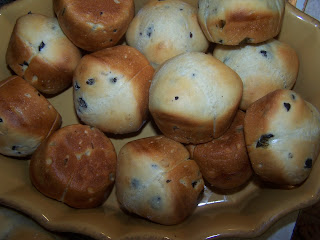 |
| Baked, but not totally browned, that will happen tomorrow right at dinner time |
My favorite cooking method is baking. And I do not really agree that it is more any more scientific or any more in need of precise measurements than top of the stove methods. It just doesn't allow you as many places along the way to correct your course.
 |
| Black Olive and Caper rolls, ready for a little more browning tomorrow |
My mom would always bake bread in very large batches, and we would consume it like locust. Our bread bible was Fannie Farmer, and she usually made some variety of hot water bread made with lard or basic white, made with milk and butter. There would be multiple bread loaves, standard dome topped, crusty and course grained. And we would always make a large pan or two of cinnamom rolls (See late sept/early october in my blog posts). And we would always fill up the stray muffin pans with cloverleaf rolls. three balls of dough in each tin, with one surprise four leaf clover to a pan.
 |
| Black Olive and Caper dough, after first punch down |
 |
| Rosemary roll dough, portioned and ready to shape |
So the recipe? At this point I do not bake most of my bread from a specific recipe, althouh they all fall directly from the breads I made with my mom. The ratio when I want to make some impromptu bread is one cup of very warm liquid, 1 scant Tbl. dry yeast, and 2-1/2 to 3 cups of flour. Additional needs are a little sugar to encourage yeast growth, a little salt to add flavor and keep yeast growth in balance, and some fat.
 |
| Cloverleaf rolls, shaped and ready to rise. See the four leaf roll ? . . . |
 |
| Rosemary rolls at the top, plain white rolls knotted at the bottom |
1/2 cup of very hot water
1/2 c. of very hot milk
1 pkg. (about 1 tbl. yeast)
1 tsp. salt
2 tsp. sugar
2 Tbl. butter
2-1/2 to 3 cups flour
Dissolve yeast in hot water, stir and let foam up a little. Add salt, sugar, hot milk and butter and stir. Add one cup of flour, stirring to completely mix. Add more flour, a little at a time until dough is stretchy and does not stick to your hands. Go light, you can always add more flour as you kneed the dough.
Place dough on a floured board or counter and knead for about 5 minutes or until smooth and bubbles are starting to form. Place in a greased bowl, rolling around so it get the top and bottom evenly oiled. Cover bowl and let rise for about 60 minutes. Punch down when doubled in size. (You can use rapid rise yeast, in which case cut all rising time in half).
Knead a little and replace in bowl and let rise a second time. about 30 minutes.
Heat oven to 350 degrees F. Punch down dough and let rest for about ten minutes, covered. Shape dough and place in well greased pan. Let rise for another half an hour and then bake until done. Time varied depending on the shape and size of the loaf. Rolls about 18 minutes, loafs about 35 to 45? I just watch them.
Remove from pans and let cool on a rack. Or eat hot.
Comments
Post a Comment